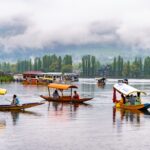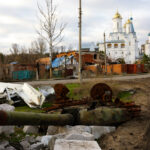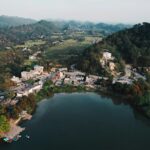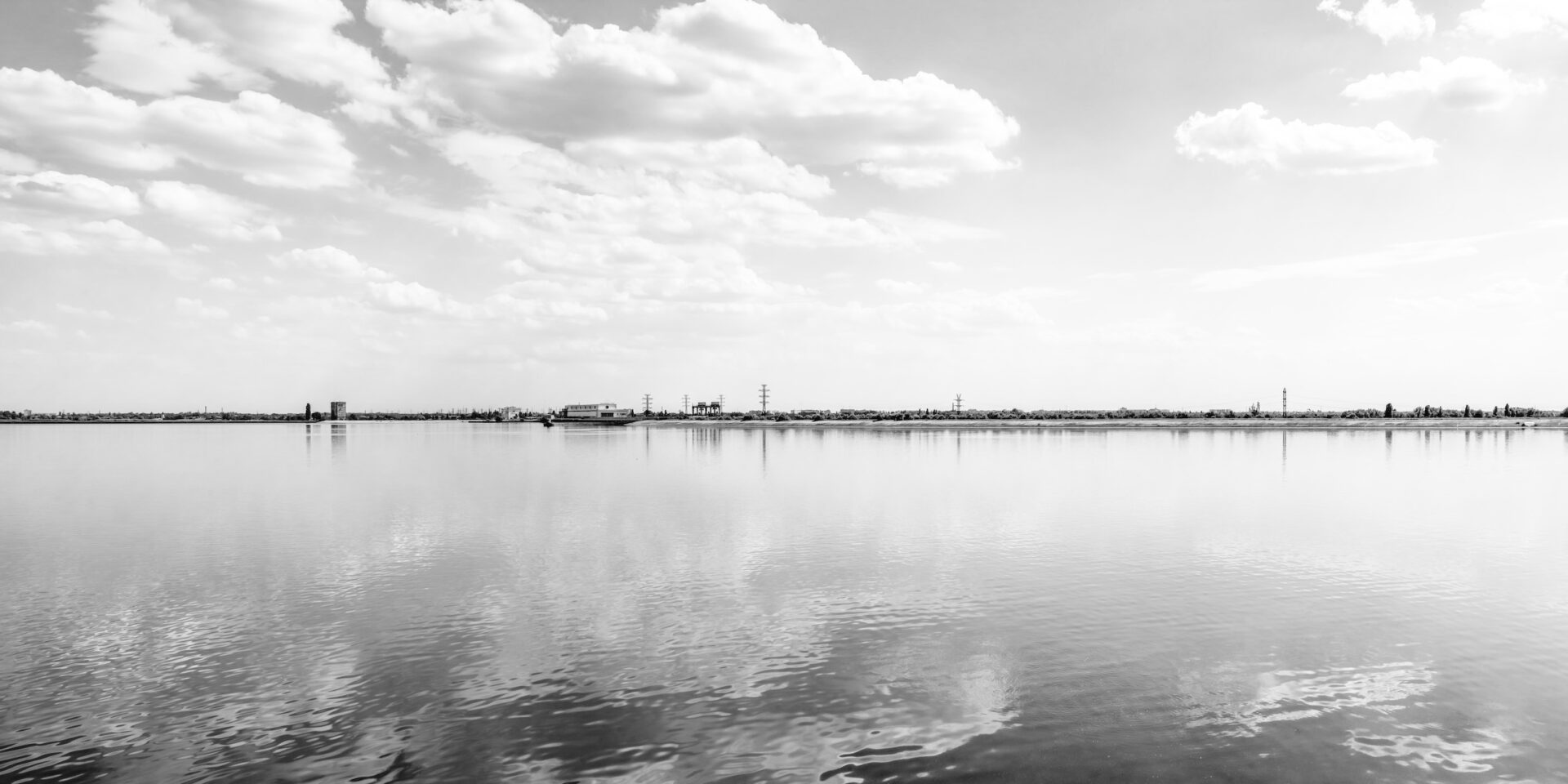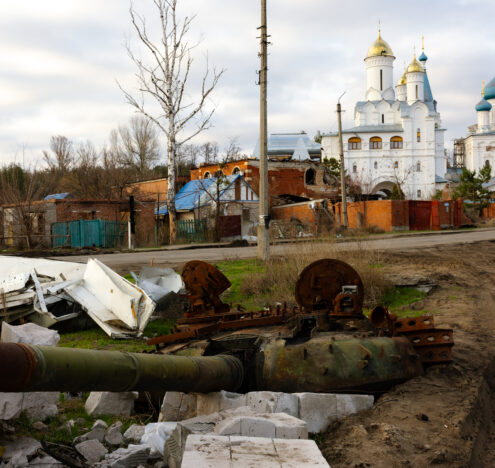“In the morning, the water stream was crazy,” Tania Kniazeva said, “The flow carried everything: there were mines and military equipment.”
“In an hour, I saw that the water level increased by 40 centimeters,” she added.
Tania is a resident of Kherson, a city with 300,000 residents in the South of Ukraine. Located right next to Ukraine’s biggest river, Dnipro, it is only 50 kilometers away from the Kakhovka dam, which exploded on Tuesday. Ukraine blames Russia and Russia blames Ukraine for the attack, and to date the culprit has not been verified. According to experts, an internal blast is likely to have caused the destruction of the Russian-controlled dam.
“The river is growing larger and larger,” Tania continued, “I’ve seen houses going under, and I can only imagine what’s happening on the lower left bank of Dnipro.”
“In Kherson, we’ve got some safe places still, but many people are coming here after fleeing from the lower areas,” the woman added, “I know that in the occupied areas, it is much worse, and people are sitting on the roofs because Russians didn’t evacuate people.”
Nova Kakhovka dam holds back a major reservoir in Southern Ukraine. It has been under Russian occupation for more than a year. Already in October last year, Ukraine’s President Volodymyr Zelenskyy warned that Russians were planning to blow up the dam, endangering hundreds of thousands of Ukrainians in the area, not to mention other risks.
In November 2022, Ukraine liberated Kherson and other nearby areas on the right bank of Dnipro. The dam, however, and other parts of the region on the left bank remained under Russian control. The left bank is lower than the right one, so while the dam’s destruction will affect Ukrainians on both sides of the river, the ones under occupation are going to suffer much more.
Tuesday Morning
Tania’s house in Kherson is relatively close to the waterfront, and from her home, she could easily spot the unusual stream that started on Tuesday morning. Around 6 o’clock, many locals began getting messages that the Nova Kakhovka dam was blown up. The information started spreading through Telegram channels and messengers, and people from Ukraine-controlled areas could communicate with those in Russia-occupied territories.
“It was so bizarre to look at the water in the morning and see that powerful flow,” Tanya recalled, “A lot of Russian equipment was flowing through the stream while Russians were still trying to shoot at the city. Basically, they knew that people would be evacuating, so they kept on targeting Kherson to prevent locals from leaving the endangered areas.”
“A lot of Russian equipment was flowing through the stream while Russians were still trying to shoot at the city. Basically, they knew that people would be evacuating, so they kept on targeting Kherson to prevent locals from leaving the endangered areas.”
At first, some people didn’t realize what was happening; many refused to leave.
“When the water started coming, some neighbors thought it would stop quickly, and it would not reach the houses and residential areas,” Tanya explained, “But in a few hours, we realized that we had to go because the water kept on coming.”
“I saw lots of wild animals trying to get to safety as they were roaming around the streets of my city,” she added, “They ran from the nearby areas that were already under the water and were moving together with people to places that were still dry.”
By Wednesday morning, three entire districts of this large city were already completely underwater. Many of the 300,000 residents had to flee to other parts of Ukraine because their houses were gone.
“Luckily, I got a boat, and I could navigate,” Tanya said, “My house is still okay, too, so I was not as bad as others. I helped evacuate some animals and people in the areas where it was still possible to get in. But there are areas where the stream is really strong, and where it’s impossible to get in.”
“So many people, elderly and immobile, are probably dead because of this crime,” she continued.
“And the water is really cold, too,” the woman added.
The Dam
The reservoir at the base of Nova Kakhovka dam is roughly the same size as the Great Salt Lake in Utah and half the size of the EU’s biggest lake, Vanern. In the past, it provided water for large areas in Southern Ukraine. The reservoir was also a main source of water for Russian-occupied Crimea. When Russians annexed the peninsula in 2014, Ukraine blocked the channel linking water from Nova Kakhovka and Crimea suffered a water crisis. Occupying the dam in 2022 was a strategic move for the Russians.
Thanks to the dam, Ukraine also maintained a hydroelectric station in the area, which contributed about 2% of Ukraine’s electricity usage, so the damage is expected to come mostly from the destructive flooding, though it may have minor implications on Ukraine’s energy infrastructure that has already been badly damaged by Russian missiles.
Because the reservoir was a key source for cooling the Zaporizhya nuclear plant — located nearby and also under Russian occupation — the explosion sparked fears of nuclear dangers associated with the attack. There are several backup water supplies that can be used, meaning that the risk of catastrophe has been averted for now, but IAEA Director General Grossi said in a statement, “This is making an already very difficult and unpredictable nuclear safety and security situation even more so.”
The dam’s destruction has affected at least 300,000 people living on the right and left banks of Dnipro — residents of Kherson, the biggest city in the area, as well as smaller towns and villages. Some are already under water such as the village of Oleshky in the Russian-occupied territories, some 20 kilometers from Kherson. Ukrainian government cannot access these territories to help with evacuations due to Russia’s control. In Ukraine-controlled areas, the evacuations were complicated by constant shooting from the Russian side.
“They were targeting us when people were fleeing,” Tanya said, “They knew that civilians are trying to get to safety, so they launched massive mortar strikes. So you can imagine — people had to escape both the water and the Russian fire.” According to Tanya, Russian mines and other military tools were carried in by the water stream, endangering the situation in the city. And she worries that these mines could detonate.
Occupied Areas
“A bunch of villages in the Oleshky district are badly affected,” said Yevhen Ryshchyk, Oleshky’s mayor. Oleshky is a small town near Kherson under Russian occupation. While Yevhen could escape and now lives in the Ukraine-controlled part of the Kherson region, he keeps in touch with locals remaining in Oleshky and nearby villages. “I received reports from locals that parts of the villages went underwater in a matter of hours,” he said, “We cannot help people there, and we keep getting reports that the town of Oleshky is getting underwater, too. The newest update is that the water level increased by at least three feet.”
The mayor warned that there is an increased risk of infectious diseases as a result of the floods, and there is an expectation that the water levels will increase even more in a few days. The water level is projected to peak in the 3 to 5 days following the dam’s explosion.
“In the beginning, locals hoped that Russians would evacuate them,” the mayor said, “There were some unconfirmed reports that so-called authorities would provide boats or buses to get the people out. However, as the mayor stressed, this did not happen. “Russians left people on their own,” the mayor continued, “There are no boats, and there is still a curfew in the occupied areas. Those who tried to evacuate on their own were prohibited from leaving the area. This is genocide.”
There are reports and drone videos of Ukrainians stuck on their rooftops in the occupied areas, unable to leave — with no help on the way. There is no information on how many people are dead or missing in the Russian-controlled areas as a result of the catastrophe; the World Data Center projects that the left bank will be 8 times more affected than the right bank.
Humans are not the only ones affected. Many animals have drowned because of the floods. In Russian-occupied Nova Kakhovka, nearly 300 zoo animals were killed. The Russian administration didn’t allow staff to release the animals, so most of them died in their cages. Only birds — ducks and swans — survived.
The dam’s destruction is going to affect at least 80 towns, cities, and villages, and its impact on Ukraine’s ecosystem is hard to overestimate — it has already been referred to by Ukrainian President Zelenskyy as one of the biggest environmental disasters of the era and the UN’s Secretary-General António Guterres has labeled it a “monumental humanitarian, economic and ecological catastrophe.”
In addition to the damage to people’s homes, the damage done to the ecosystem — including natural resorts and fertile soil — may be irreversible, according to Ukrainian environmentalists, and carry all of the characteristics of ecocide. According to the environmentalist Lyudmyla Tzyhanok, the dam’s explosion will lead to the transformation of the entire ecosystem of the region. In addition to impacts on drinking water in the area, the dam’s destruction will lead to the death of a huge number of fish, waterlogging of drained lands, and up to 1.5 million climate refugees from the affected areas.
“We’re going to get a new desert…” she said in an interview with Voice of America, “And this will lead to field storms, rising temperatures in the region, and a drought risk.”





